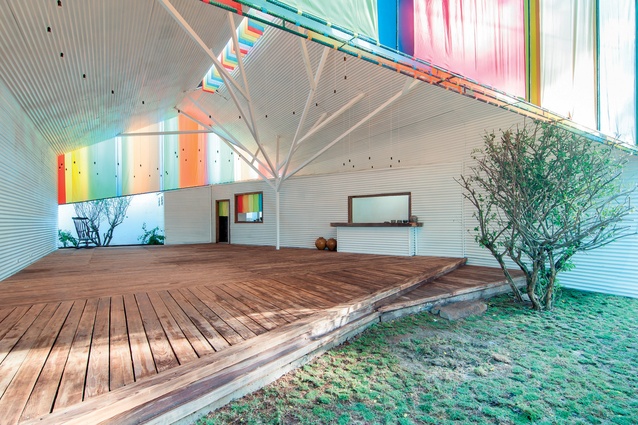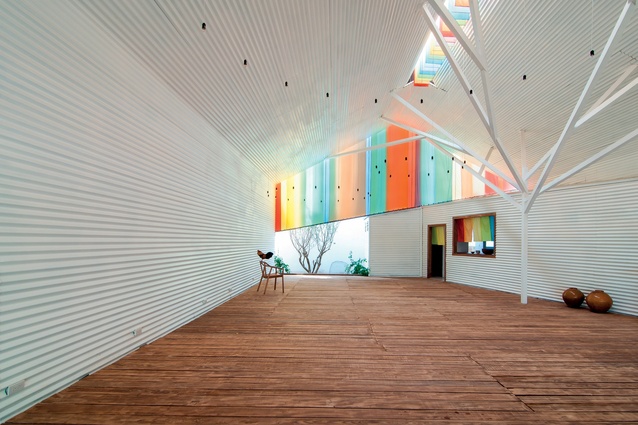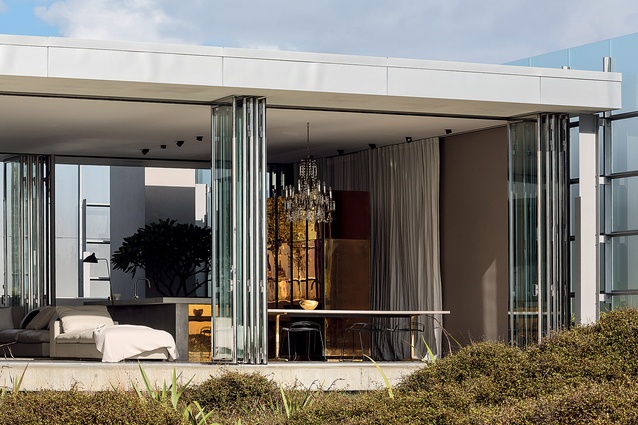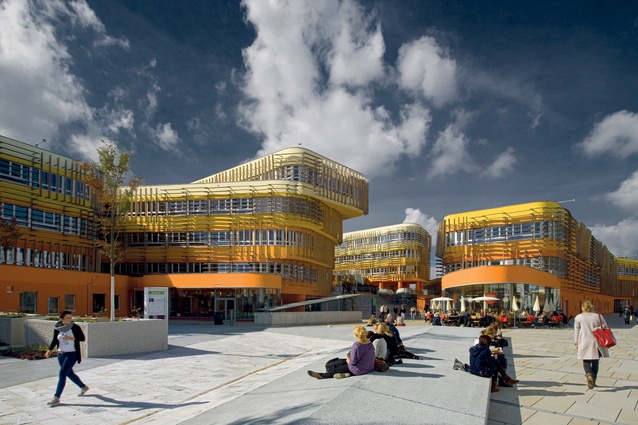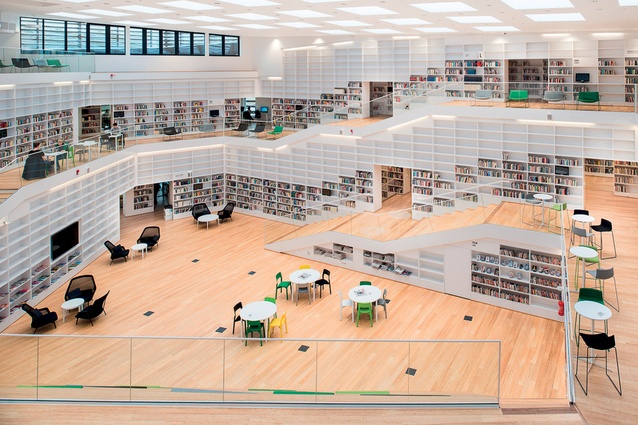2014 World Architecture Festival
With seven New Zealand projects short-listed for the World Architecture Festival held in Singapore late last year, our architects were out in force at the Marina Bay Sands Conference Centre. Architecture New Zealand magazine's editor Justine Harvey was a judge and here she talks about her experience, while architects Richard Naish from RTA Studio and Jeremy Smith from Irving Smith Jack Architects offer up a few anecdotes.
Dean Sharpe, a Kiwi designer living in Singapore, described the country as “a test case for racial harmony”. There is certainly something positive to be said for a country where there is no real dominant race but a mash-up of peoples from around the world. Developers, architects and planners can take something from this: that mixing up peoples of differing ages, races and incomes is a better way of nurturing understanding between peoples, creating more egalitarian societies, than is creating the elitist enclaves that are increasingly dominating inner cities around the world.
At WAF, there are many talks given by the big-name architects and while, generally, they were interesting, I found the smaller, more-informal off-shoot talks to be the most honest and engaging. In one of them, WAF programme director Paul Finch described London’s centre as “a zombie town” where “everything is owned but nothing is occupied”. “Life is vanishing off the streets,” he said. “There is a perceived shortage of housing at low cost but that is led by the ‘super prime market’, which is about overseas investors buying in prime sites. Governments are not meeting real housing needs.”
This issue is just as relevant here, in New Zealand, as it is in the UK. Making money is important but it is a high price to pay to lose communities, cultural stories and historic buildings in order to make money. What are we prepared to lose in order to fuel the high end of the market? And how much land do we sell off to non-residents? Where exactly do we draw the line?
A recent article published in The Guardian newspaper stated that, according to an OECD report, New Zealand has created one of the most dramatic gaps between rich and poor in the OECD. New Zealand is “no longer the egalitarian paradise it once was” so, perhaps, we need to ask ourselves: What is a sustainable existence for our country and our cities?
At another talk, one of the most engaging I attended at WAF, two architect/developers, Marco Goldschmied, co-founder of Richard Rogers Partnership, former president of the RIBA and now a director of SPARK architects, and Roger Zogolovitch, chairman and creative director of Solidspace in the UK, asked: “Are regulations in cities a good thing or a necessary evil?” Zogolovitch stated: “It is insane to think that we can predict the future. We cannot plan for the future so the regulations that sit behind them are irrelevant. The regulatory system
needs to come up with ideas to embrace informality.”
“The regulations around medical care or even education can be changed quite quickly but the effect of regulation on a city remains there far beyond the people who made those decisions,” Goldschmied added. “Creative people have always been wary of censorship and regulation… regulation and creativity don’t mix and, for younger architects, regulation is a killer, resulting in lower fees, more time, etc. … But the unregulation of design is potentially broadening the experience of a city.”
In the discussion following the talk, curator, film-maker and writer Jeremy Melvin summarised with: “The regulation of cities needs to be very light on design, intelligent on density, flexible on land use… and consistent across the decades, not at the mercy of capricious politicians – used as an electoral plaything”. Zogolovitch added: “Anyone who tries to predict how a city should grow is bonkers. Physical masterplanning is crazy. Strategic masterplanning is absolutely essential. We need a light but clear regulatory framework. The Dutch weren’t afraid to be brave; they didn’t see creativity as a threat… We shouldn’t think of ourselves as architects; we need to think of ourselves as political activists. We don’t change it by design. We change it by political action and active citzenship. Architecture has a limited capacity to change the world, especially poverty, to achieve the kind of ends we require.”
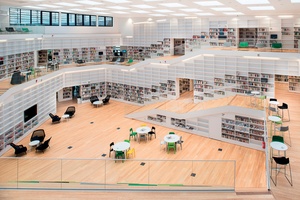
Some of the best conversations had at WAF are often randomly found. At one talk, I was pleased to sit next to Lars Autrup, head of projects at the Realdania Foundation in Denmark, a philanthropic organisation or ‘change agent’, whose mission is to ‘improve quality of life and benefit the common good by improving the built environment’. Apparently, Realdania was originally funded by a pot of dough left over from the merger of two banks and to which any real estate owner can now join. The Foundation finds worthy projects to create, then commissions talented architects to design them and asks the government to cough up half the money for the scheme while it pays for the remainder. The results are typically architecturally award-winning and the organisation has been commended for encouraging broad, cross-sector coordination and collaboration.
I joined a panel, with Turkish architect Murat Tabanlioglu and Wong Chiu Man from WOW architects in Singapore, to judge the Higher Education category, which was a fascinating and enjoyable experience. We heard presentations for two of Zaha Hadid’s projects, a Peter Cook scheme, quite a few Australian projects and others. It was incredibly intense and, without one standout winner, it was a case of weighing up pros and cons. We went for Dalarna Media Library, Sweden, by a young Danish practice, ADEPT. It is a highly flexible space that responds to a young audience and how it operates; it feels as though it would remain fresh and alive over time. It consists of a sunken gathering space or theatre surrounded by a ramping spiral of books, each level leading outwards into more private spaces, nooks and crannies.
I do think that judging is pretty subjective and critical judgement does alter depending on the ‘mood’ of the moment, how entrenched a judging panel is or how persuasive some judges are. However, at WAF, the judges tended to be more random, coming from different parts of the world and being of both genders. I’d like to see more architects from Africa and other countries not typically represented in architecture, who could, perhaps, offer up different perspectives.
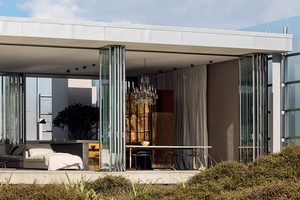
It was fascinating to see the New Zealand architects’ work pitched against leading overseas architects on the global stage. I was hugely impressed. The Kiwi architects more than carried their own, all with differing styles and presenting very different projects. And they talked about ‘context’ unlike many other architects, including Peter Cook. In the Villa section, Jeremy Smith of Irving Smith Jack Architects gave the most friendly, and probably the most informal, presentation of the conference – wearing his signature surfer hairdo and jandals – for his practice’s offSET Shed House near Gisborne: a low-budget seaside bach clad in corrugated roofing, with no fences, which invites the community in. The European judges seemed slightly dumbfounded by the use of the iconic Kiwi material and didn’t quite understand this low-key cultural approach, which was more to their discredit, I thought. Richard Naish from RTA Studio and Jeff and Tim from Fearon Hay Architects gave modest but polished and engaging performances for Emerald Bluffs House and Dune House, respectively. The crowds watching the presentations spilled out the doorway, much like the audiences at the starchitects’ presentations; I wasn’t sure if their success was because of the architecture or the incredible New Zealand landscapes or Jeremy’s jandals. All three, perhaps.
Unfortunately, I couldn’t attend some of the other New Zealand project presentations because I was either judging or in meetings. James Grose from BVN Donovan Hill presented a number of projects including the Regional Terminal at Christchurch Airport in the Transport category and ASB North Wharf in the Office category, both by BVN and Jasmax. He also presented another BVN project in the Higher Education category that I was judging. Wow, he was slick: one of the most charming presenters I’ve watched, he really had the narrative tied down and engaged directly with the judges and audience. Although, for me, I found the project interesting conceptually and visually, the form and materiality didn’t seem to marry with the context as was suggested in the narrative.
I missed Andrew Patterson’s presentation of the striking Christchurch Botanic Gardens Visitor Centre but I heard that it went well, although the omission of photographs of the back end of the building, where the gardeners do their thing with wheelbarrows and seedlings – essentially a series of working spaces – gave the judges too many unanswered questions. Andrew said that it was a lesson for presenters to leave no stone unturned. Indeed, presenters need to be succinct but incredibly thorough: justify the simplicities with a nod to budget and practicalities.
In the end and up for the Supreme Prize, Fearon Hay came through with Dune House from the Villa section and Te Kaitaka ‘The Cloak’ in the Display (Completed Buildings) category. Jeff and Tim had to present to the Super Jury, which consisted of Richard Rogers, Rocco Yim, Julie Eizenberg and Enric Ruiz Geli and an audience of hundreds. They did very well, even when grilled extensively. Richard Rogers loved the Dune House, describing it as “a very functional and beautiful house”, although, in his final analysis of Te Kaitaka, he commented that “architecture should be light” and that its roof form is too heavy. But this is where I disagreed with my former boss; his view seemed like a very Western architectural perspective. While Jeff and Tim were standing under the spotlight, it probably didn’t spring to their minds to explain that a lot of traditional Polynesian buildings, such as the fale and some Ma-ori raupo buildings, have heavy roof forms for various social, environmental and spiritual reasons. And that, viewed from afar, you barely notice Te Kaitaka because its brass-and-grass roof merges into the natural landscape, in contrast to its neighbouring buildings: mainly flat-fronted glass boxes that could be anywhere. In this context, it’s light on the land.
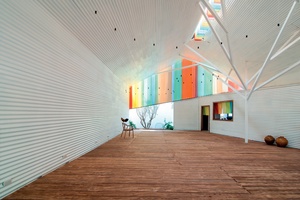
But I wish I were a betting person because I predicted the Vietnamese Chapel project by a21 Studio would win and it did. I’m no soothsayer but, having worked out a little bit about the judges’ preferences, I guessed they would enjoy its lightness. Indeed, it is light, lovely and creative, colourful and forward-looking and sited in a poor area that really needs a joyful community project. Coincidentally, my onward journey led me to Vietnam and I spent a lot of time in a taxi in Ho Chi Minh City looking for this project in the rain, only to find out that the address I’d been given was incorrect. While I missed visiting the Chapel in the flesh, I was able to explore the outer suburbs of the city to discover some very basic and informal areas with little investment but possessing identity, urban pace and exuberance, evidently rich with the intricacies of many lives really being lived.
Late one balmy Singapore evening after a long day at WAF, I ended up at one of the local hawker markets with Jeremy and Andrew from Irving Smith Jack Architects and Peter Rich from South Africa, trialling the delicious indigenous foods from the many stalls that line these basic food halls; each dish costs well under $5 so, for Singaporeans, it would hardly be worth cooking at home. The taxis are unbelievably cheap, too: perhaps half what you’d pay in Auckland. I was fascinated to learn that the taxi drivers in Singapore have to have been born in Singapore. One of them explained to me that the government sees a taxi driver as being an overseas visitor’s first interaction with the place and so all drivers have to know the city well or they’re in trouble. But Singapore is forever evolving, as one driver explained: “Singapore is always changing. That is why tourists always want to come back here.” In 2015, WAF will indeed be back in Singapore (this time at Suntec Convention and Exhibition Centre) but, in 2016, who knows? I’m gunning for Auckland.
Architects at WAF
RTA Studio’s Richard Naish
After six years of WAF in both Barcelona and Singapore – what draws us back? I guess it’s the opportunity to gain an annual snapshot of global architecture in a unique blend of live award crits and conference-style presentations. It sits somewhere between The X Factor for architects and a sort of architectural Olympics, where any athletic talents are replaced with persuasive verbal deliveries and beguiling visuals. And, just like at the Olympics, the Kiwis punch well above their weight. This year, the Kiwi camp took out two categories – all credit to Fearon Hay – and this crystallises what is great about the event.
It pitches the Davids against the Goliaths and architectural aristocracy against commoners, demonstrating that size doesn’t necessarily matter but quality, rigour and interrogation of the problem do. With some great results now mounting among New Zealand’s architects over the last few years, I would encourage more practices to participate. At least NZIA New Zealand Award winners could all be capable of being short-listed – bring it on 2015! At worst, the live presentations of New Zealand’s work to international judges are valuable experiences and great opportunities to survey the world’s work over a multitude of categories. Not to mention the Singapore slings, Szechuan chicken and rooftop bars!
Irving Smith Jack Architects’ Jeremy Smith
Highlights for me this year were the Vietnamese architects, Richard Rogers and Chinese dumplings.
WAF 2014 in Singapore was the third iteration at which Andrew and I have presented work, previously competing in Barcelona 2011 and Singapore 2013. It is a long way to go for 20 minutes of talk but, if you like some open critique and feel like saying something through your work, then what can possibly go wrong? Well, quite a lot in some cases, given the mix of languages, nerves, money and egos on display – it is, after all, a competition with a jury, a stage and plenty of opinion, both good and bad. It did take two days before I heard the phrase “architectural masturbation” if that is any guide. We were busy. Besides presenting our offSET Shed House on stage and then, by request, to a few heroes, Andrew’s lecture on our work as part of a World Architecture Update was very well received, and I finished up officiating on one of the Super Juries with some very-well-dressed Italians. The architecture is, of course, wonderful (and well done to Jeff, Tim and Fearon Hay) but people are the real joy in any international adventure, both those you tour with and those you meet. Good also to see that starchitects still have to queue for taxis. It was fun and we now have the enticing prospect of collaborating with
an international practice that we got to know better in Singapore. And the winners? Best game was looking for walls in the Vietnamese projects.
Best architecture, Vietnam.
Singapore-based Interior designer, Dean Sharpe
It was a proud moment to see three of New Zealand’s top architects up for the Best Villa award, with Fearon & Hay taking the top spot. Living in Singapore we are surrounded by numerous leading global architectural firms, and New Zealand is still pushing out the boat in innovative designs against larger firms and much larger budgets as seen during the awards. Big budgets do not necessarily relate back to good design or architecture.
After spending several days listening and taking in the different category presentations and discussion groups, it hit me that the majority of the presenters lacked the ability to sell there designs. The architecture presentations were flawless but communicating the design fell short in a lot of cases, making the job for judges and facilitators rather difficult. The companies that were articulate often stood out and not because the design was any better or worse; they were just able to sell the concept better. Hence I personally feel that the workshops offered to the wider design body should include master classes in areas that designers are unfamiliar in: media presentation, selling to an audience, new presentation software, networking and how to build connections with global clients.
In saying that, I totally enjoyed seeing where we are taking design and architecture; a sense of responsibility that our countries and leaders are now seeing in responsible urban developments and redevelopments.

